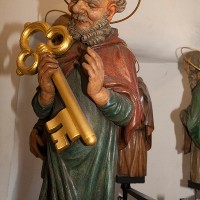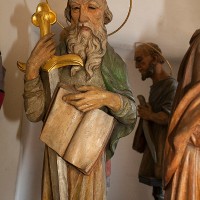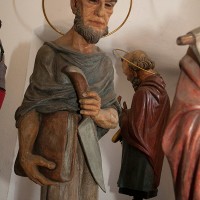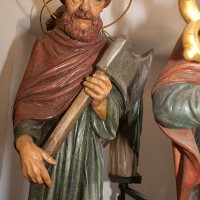Breadcrumbs navigation
Apostles Figures
When the clock strikes the hour, the procession of the Twelve Apostles, Chrisťs disciples, and other figures on the astronomical clock are set in motion. The apostles appear in the windows of the clock, where each can be recognized by his attribute. Looking below, you can see for yourself who is who in the parade, which order they come out, and which attribute each carries.
 St Peter – key
St Peter – key
He is considered the first of the apostles and also the first pope in the history of the Church. He is likewise the one who starts the procession of the Apostles on the Prague Astronomical Clock. He was called to become the fisher of men; which is why he is the patron saint of fishermen. Christ gave him the key to the kingdom of heaven, which became his attribute.
 St Matthias – axe
St Matthias – axe
The axe is the symbol of St Matthias because his marfyr's death took the form of beheading. He is the patron saint of construction craftsmen, confectioners, and tailors.
 St John – challce
St John – challce
John the Apostle and Evangelist was first the disciple of John the Baptist and later Jesus Christ. He is the patron saint of clerks and notaries, as well as sculptors, painters, scribes, writers, booksellers, printers, engravers, and book binders.
 St Andrew – X-shaped Cross
St Andrew – X-shaped Cross
He was a fisherman and Chrisťs first disciple. He is the patron saint of farmers, fishermen, and brides. The X-shaped cross accompanies him because he was martyred on such a cross. The feast of St Andrew used to be considered the most important prophetic day of the year.
 St Philip – a cross
St Philip – a cross
St Philip the Apostle lived in the 1.st century. He made his living as a fisherman, and was later among the early followers of Jesus Christ, preaching the gospel in Asia Minor. He is the patron saint of hatters, tanners, confectioners, and shopkeepers.
 St Jacob Less - fuller's club
St Jacob Less - fuller's club
St James was Jesus Chrisťs favourite apostle. He died a martyr's death. According to the Golden Legend, he was stoned and beaten to death with a fuller's club, which became his attribute.
 St Paul – sword, book
St Paul – sword, book
St Paul of Tarsus, or Saul, who was credited with being among the first to spread Christianity among the Gentiles, is usually depicted with a sword or a book. The New Testament tells of his fate. He is the patron saint for those in fear, weavers, and rope makers.
 St Thomas – lance
St Thomas – lance
He was a builder and bricklayer, later he probably worked as a fisherman. As one of Chrisťs disciples, he is often referred to as Doubting Thomas.He is the patron of archifects, bricklayers, builders, architects, geodesists, surveyors, design engineers, stone masons, construction workers, carpenters, and theologians.
 St Simon – saw
St Simon – saw
He was also called Zealot. He spread the gospel and underwent martyrdom when he was first crucified and then put to death by a saw, which become his attribute. He is the patron saint of lumberjacks, dyers, and tanners.
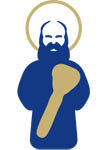 St Jude Thaddaeus - club
St Jude Thaddaeus - club
Jude Thaddaeus was a faithful follower of Jesus Christ, often referred to as The Magnanimous. He is the patron of those in severe distress and a protector in hopeless situations.
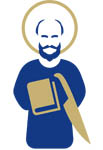 St Bartholomew – pelt
St Bartholomew – pelt
According to tradition, he came from Cana in Galilee and spread the gospel in Asia Minor and the Arabian Peninsula. According to legend, he was sentenced to the Persian capital punishment, i.e., skinned and crucified. He is the patron saint of butchers, tanners, fur trappers, cobblers, tailors, and boot makers.
 St Barnaby – scroll
St Barnaby – scroll
He lived in the 1st century and was among Chrisťs first disciples. Originally from Cyprus, he mainly spread the gospel in Asia Minor and Cyprus. Legend describes his death by stoning. He is the protector against devastating fires and the patron of coopers and weavers.
